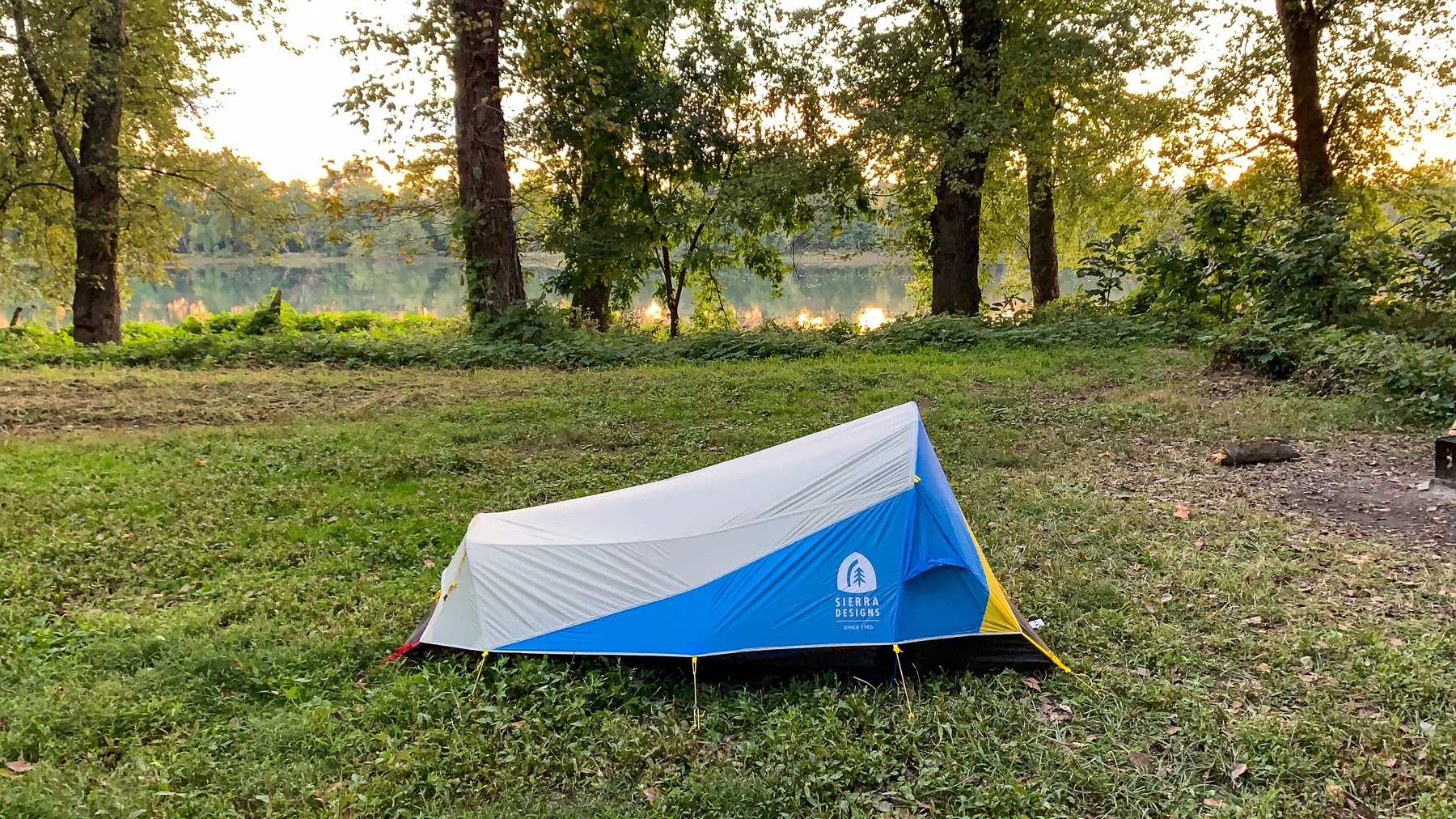Pros
- Fairly light and compact; pole sections are short and designed for easy bike packing
- Good water shedding (tested through several hard rains) as long as you correctly stake and tension the fly
- Decent amount of vestibule space; you can fit shoes and helmet on the non-door side
- Fast and intuitive setup/takedown
- Awning allows for some interesting possibilities
- “Buritto” stuff sack is neat and fast once you get used to it
Cons
- Ventelation isn’t great with the fly down. I had a fair amount of condensation every morning so ended up packing a damp tent even on dry nights
- The supplied pocket is nice and large, but I have no idea why they didn’t put one on each side
- You need to do a bit of “tent yoga” to get dressed inside
- I would have loved about 2 more inches of length as my feet hit the bottom of the tent
Bottom Line and Vendor Relationship(s)
This is a solid solo bikepacking tent that checks all the boxes: it’s light, straightforward setup/takedown, and keeps you dry. There’s a decent amount of headroom, although the low foot area requires you to turn on your side to dress/undress. There’s good shoulder room and my 6′ 2″ mass never felt claustrophobic or cramped. The small packed size would allow storage on your bars or in the cage, and it fits horizontally in panniers. Definite buy when on frequent sale.
I have no special relationship with Sierra Designs, however I’ve owned their tents for years, and my beloved single-wall 4-person family tent started disintegrating. I contacted them and was disapointed to discover that new “environmentally friendly” coatings apparently self-destruct about about 7 years, and internet research confirmed that diagnosis. After some email back-and-forth their warranty department offered me 40% off which I used to purchase this tent.
You can buy this tent through your favorite suppliers. Sierra Designs seems to offer fairly frequent sales as do the “usual suspects” like REI and Backcountry.com I won’t provide an Amazon “affiliate link” since Amazon pricing seems much higher than others. Please do check out the bicycle trouing gear list for any shopping needs and use those links to fund water buffalo leach removal.
Detailed Review
I secretly love tents, a love that started when I setup my first Eureka Timberline at some sort of scouting function when I was 8 or 9 years old. I was fascinated by the shock-corded poles (SNAP, so cool!), and amazed by the little plastic tube with carefully oriented holes that held the three poles of the A-Frame together. Every time I get a new tent I get excited to see what tricks tent designers have come up with as they’re usually so simple yet ingenious. I remember getting my first tent with color-coded poles and corners, or my first tent with lightweight Easton poles. In some ways I’d really like to meet a tent designer, although in other ways I feel like I’d be a bit let down, like when you find out your favorite celebrity has a drinking problem or “political awakening” that triggers ham-handed twitter posts.
I was excited to get the Sierra Deigns High Side as it’s been years since I’ve owned a 1-person tent, and it was billed as being designed with bicycle travel in mind. It’s a svelte 2.5 lbs with the footprint, and has a neat “awning” feature that allows the door-side rain fly to be configured as a large vestibule, awning, or large “screen door” when rolled up.
At a list price of $280US it’s not cheap, but it goes on sale fairly regularly, and someone once suggested I think of tent prices in their “hotel night equivalent.” So on a six-night trip where OK hotels might average $75/night, the tent pays for itself on night 4. Maybe this is a silly psychological game, but I’ve also found that regardless of how many people it sleeps, you generally need to get into the $300 range to get into the “sweet spot” of water resistance, quality assembly/materials, and light weight.
Setup
Assembly is fairly easy. I purchased the matching footprint as I usually do, and once I’ve found where I want to setup, one rolls out the foot print to start. The key to remember is that the corner with the red grommet is the back non-door side. Next time I have the tent out, I’ll probably write that in silver sharpie on the footprint since it might save the 50/50 gamble of setting up on the wrong side, although adjustment only takes a few seconds.
A quick word about picking a location for your tent: obviously somewhere flat that is not the lowest spot in the area (lest you find yourself in an impromptu lake during a rain), but also avoid any large branches overhead if possible. You don’t want anything falling in a wind or due to sheer dumb luck and end up trapped, busted up, or dead.
With the footprint out, once lays out the body of the tent, matching the “red corner” to the footprint, and stakes the 4 corners. Next are the poles, both color coded and quick to affix to grommets and clip in. I liked that I could straddle the tent and work from back to front, making initial setup fairly quick.
Next is the rain fly, with similar color coding. This is where things get slightly nuanced, in that you need to Velcro the fly to the poles before attaching the corners using plastic clips. These Velcro loops are key for correctly positioning, and maintaining proper tension on the rain fly.
Fly attached, it’s important to stake out all loops on the fly. If your fly isn’t well-tensioned, water can pool in the foot area as I discovered during my first night in the rain. Nothing leaked, but there was a “divot” of water dangerously close to my feet that I avoided during future rainy nights with proper tensioning.
During this process you’ll have to decide on your “awning” configuration. There’s a large section of rain fly at the door that can be fashioned into an awning by guying the corners to a tree or bicycle. This seemed super cool when I read the marketing material for the tent, but I didn’t find myself using the awning configuration, probably because I didn’t have any rain during mealtime on my outings with the tent, which is where it would seem to be the most useful. I did appreciate the large vestibule, and the ability to roll it up and have a nice view of the universe, while also having the ability to quickly batten down the hatches, an ability I tested when my Spidey sense woke me up moments before a downpour one evening.
All in all, setup is easy and straightforward, and I never found myself wishing for a third hand or foot as I have with some other 1 or 2-person tents.
Living in the High Side
Not-a-newsflash: 1-person tents are small. However, my 6′ 2″ girth fit well, and good shoulder and torso room never made this tent feel claustrophobic or “coffin-like.” I slept fine on back and side, and could toss and turn without much worry. Getting dressed is a bit challenging, as the tent is low by your feet and mid-section. The relatively obvious (as in “d’uh, why didn’t I realize this 2 nights ago obvious) solution is to roll on your side for donning and doffing pants and socks. You’ll still get a low-grade ab workout for shirts, but the high-ish roofline near your head allows for a god degree of arm flailing. I could not however sit up, and I would imagine you’d have to be quite small to do so.
There’s good room for gear around your head, and I could stash phones, batteries, headlamps, and various junk near my face without it getting in the way. There’s a single, large pocket made of mesh materials that’s great for stashing things like lights and hats that you don’t want to hunt for, although it’s odd they only supplied one such pocket.
I was also pleasantly surprised by the vestibule space. When cycling I usually have clipless bike shoes and some camp flippy floppies, and I could stash shoes and helmet in the non-door vestibule, leaving the large door area for other gear. A full-size backpack seemed like it could even fit.
Disassembly is equally easy, and the large door makes tasks like rolling up an air mattress and stuffing a sleeping bag straightforward once the rain fly is removed, since one can squat outside the door and work on those objects as they sit inside the clean tent rather than dragging them out. I haven’t (yet) had the “pleasure” of setting up or disassembling camp in a hard rain, but in that case I’d try and rig the awning such that it would keep rain off my stuff, but allow enough access to pack.
Rather than a traditional stuff sack, SD has adapted a “burito bag” across most of their tents. Picture a traditional sack, but cut open along the long side rather than the short end. This bag presumes you’ll fold and roll your tent rather than “stuff,” and allows you to put the rolled tent easily into the bag, and then cinch it all up. It’s hard to explain, awkward to do the first time or two, and then a superior solution to the old way. It’s also nice that the stuffed package includes the poles, and it all fits nicely in a pannier, cage, or bar/seat bag.
Those steamy nights
You can’t beat physics, and in this case putting a hot, steamy, bag of bones that tends to enjoy breathing in a small space, and wrapping that space in material designed to not allow the passage of water is going to create condensation. During cool nights I’d wake up to a fairly wet rain fly each morning, although the design of the fly generally allowed any beading water to roll down the sides, keeping me dry. The bummer of course is that one then has to pack up a wet rain fly and then hang it on a line to dry a bit in the evening before attaching it to the tent. The dampness of the fly also dampens the tent (and adds a bit of weight), but setting up the tent and leaving it empty quickly cures that problem.
The tent has a couple of vents that can be propped open, but again a 4″ x 2″ vent isn’t going to get all my hot, moist air out. I did try rolling the “awning” of the fly up a couple nights, however it was usually rather humid so I’d have a layer of condensation on my sleeping bag in the AM, rather than just on my rainfly. This technique should help in a dryer climate assuming no rain.
I’m not sure how this issue could be mitigated, and it’s certainly not unique to this tent. It is designed such that you and your sleeping bag don’t get wet, and the mitigation is some air drying before the next step, so it seems a reasonably tradeoff as one must make when dealing with small tents that don’t cost a small fortune for magical fabrics.
Buy, or Pass?
Buy. This is a light, thoughtfully designed, compact tent for one, that doesn’t make you feel like you’ve been put in a sack by someone with a New Jersey accent, and are about to be tossed in the back of an ’89 Impala.
If it’s under 60F the tent WILL be wet in the morning, but a few shakes and some “air time” at the next campsite is a decent alterative to lackluster rain-proofing or a $800 tent made of space-age polymers.



0 Comments